For many, the term tobacco has often been associated with cigarettes and therefore, riddled with negative connotations—particularly in regards to health and general well-being. Stripping things back a little, when we deal with pure tobacco, there’s much to be understood about its beneficial properties.


For generations, indigenous communities within South America have understood this, and have been using the organic plant to treat ailments, improve and maintain health as well as for sacred religious practises. It’s important when discussing the use of tobacco today to see the picture beyond what’s in front of our eyes.

Tobacco’s ancient properties—including but not limited to being an antiseptic and sedative—have allowed it to be used in many ways, especially in the Americas and native communities throughout the world. Not only was it used for ceremonial as well as recreational purposes, but tobacco was a tool for trade as well as medicine. Similarly to how smoking tobacco is bought and sold for business and pleasure today, it was often used as a bargaining tool along with the perhaps better known spices, tea, furs and luxurious silks that one would find during the Silk Roads.


In terms of personal and local use, the Taíno community were said to have smoked tobacco regularly. Native to the Caribbean, the Taíno people were the majority inhabitants of Cuba, the Dominican Republic, Puerto Rico and to a lesser extent, Jamaica and Haiti. This practise of smoking tobacco is better appreciated and understood today through the etymological origin of the word ‘cigar’.

‘Sikar’ was used by the Mayas for the ritual of smoking as religious practise, and was first observed and understood by Western civilization through Italian explorer and coloniser Christopher Columbus. Bartolomé de las Casas, the Spanish historian, was also said to have documented that, “Men with half-burned wood in their hands and certain herbs to take their smokes, which are some dry herbs put in a certain leaf, also dry, like those the boys make on the day of the Passover of the Holy Ghost; and having lighted one part of it, by the other they suck, absorb, or receive that smoke inside with the breath, by which they become benumbed and almost drunk, and so it is said they do not feel fatigue. These, muskets as we will call them, they call tabacos.”



With most things, excess can be damaging, but when used efficiently and appropriately there are significant positives to be gained. There are over sixty tobacco species today, with 60% of those native to South America. Only around a dozen or so contain enough nicotine to affect human beings.

The cigar as we know it today is probably the purest form of smoking tobacco — free from the additives and harmful manufactured ingredients you commonly find in cigarettes. It is therefore closer to the ancient sikar that was enjoyed by the indigenous communities of the Americas than the cigarettes smoked today.


The composition of a cigar—binder, filler and wrapper—is made using dried and fermented tobacco leaves only, making the experience a natural and unfiltered one. It’s an unfair situation for the cigar industry to be painted with the same brush as other forms of smoking tobacco which are significantly harmful, but as they say - knowledge is power. The more we know and the more we are able to understand, the greater the ability we will have to change the narrative.






